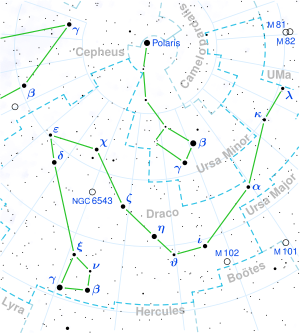Top Qs
Timeline
Chat
Perspective
Gliese 687
Star in the constellation Draco From Wikipedia, the free encyclopedia
Remove ads
Gliese 687, or GJ 687 (Gliese–Jahreiß 687) is a red dwarf in the constellation Draco. This is one of the closest stars to the Sun and lies at a distance of 14.84 light-years (4.55 parsecs). Even though it is close by, it has an apparent magnitude of about 9, so it can only be seen through a moderately sized telescope. Gliese 687 has a high proper motion, advancing 1.304 arcseconds per year across the sky. It has a net relative velocity of about 39 km/s.[2] It is known to have a Neptune-mass planet.[7] Old books and articles refer to it as Argelander Oeltzen 17415.[9]
Remove ads
Properties
Gliese 687 has about 40% of the Sun's mass and nearly 50% of the Sun's radius. Compared to the Sun, it has a slightly higher proportion of elements with higher atomic numbers than helium.[6] It seems to rotate every 60 days and exhibit some chromospheric activity.
It displays no excess of infrared radiation that would indicate orbiting dust.[10]
Remove ads
Planetary system
In 2014, Gliese 687 was discovered to have a planet, Gliese 687 b, with a minimum mass of 18.394 Earth masses (which makes it comparable to Neptune), an orbital period of 38.14 days, a low orbital eccentricity and inside the habitable zone.[7] Another Neptune-mass planet candidate was discovered in 2020, in a further out and much colder orbit.[4]
Remove ads
See also
- List of nearest stars and brown dwarfs
- List of exoplanets discovered in 2014 - Gliese 687 b
- List of exoplanets discovered in 2020 - Gliese 687 c
References
External links
Wikiwand - on
Seamless Wikipedia browsing. On steroids.
Remove ads


